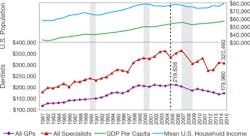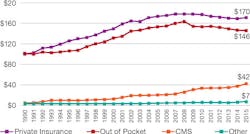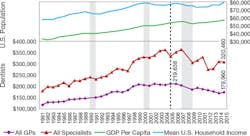Dental utilization trends: Report reflects stagnant growth in the dental profession
By Christine Nathe, RDH, MS
The latest reports from the American Dental Association Health Policy Institute (ADA HPI) present some interesting trends that impact the public’s dental health. The report, titled “U.S. Dental Spending Up in 2015,” presents information on dental care expenditures. Although dental spending did increase between 2014 and 2015, it began to decrease in 2002 and has been flat since 2008. Figure 1 depicts the source of the increase in dental care expenditures in 2015, mainly a sharp increase in Medicare and Medicaid programs.
Figure 1: National dental expenditures per capita by source of financing (in constant 2015 dollars).
Source: Centers for Medicare and Medicaid Services, US Bureau of Economic Analysis, US Census Bureau.
A Centers for Medicare and Medicaid Services (CMS) report cites states where dental expenditures accounted for only 3.7% of overall national health expenditures. Key trends include the facts that an increase in the share of dental expenditures financed by public sources rose from 2% in 1990 to 12% in 2015, and out-of-pocket spending saw a decrease. This mirrors similar facts associated with overall health spending.
The ADA HPI report entitled “Dentist Earnings Were Stable in 2015” reports that although dentist earnings did not change significantly (Figure 2), dentists reported that they were slightly busier in 2015, although they would still like to be busier. One factor was the steady decrease before the economic downturn of 2007 to 2009, and the current stagnation in dental care use among adults, which is impacted by the increase in dentists.
Figure 2: Dentist earnings, GDP per capita, mean US household income, 1981 to 2015 (2015 dollars).
Source: ADA Health Policy Institute, Bureau of Economic Analysis, US Census Bureau, Current Population.
These reports suggest trends that ultimately affect dental hygiene and the public’s dental health. Dental hygienists should stay informed and continue to promote the need for preventive and comprehensive dental care to all people. RDH
CHRISTINE NATHE, RDH, MS, is director at the University of New Mexico, Division of Dental Hygiene, in Albuquerque, N.M. She is also the author of “Dental Public Health Research” (www.pearsonhighered.com/educator), which is in its third edition with Pearson. She can be reached at [email protected] or (505) 272-8147.
References
1. Wall T, Vujicic M. U.S. Dental Spending Up in 2015. ADA website. www.ada.org/~/media/ADA/Science%20and%20Research/HPI/Files/HPIBrief_1216_2.pdf. Published December 2016. Accessed February 15, 2017.
2. Munson B, Vujicic M. Dentist Earnings Were Stable in 2015. ADA website. http://www.ada.org/~/media/ADA/Science%20and%20Research/HPI/Files/HPIBrief_1216_1.pdf. Published December 2016. Accessed February 15, 2017.
3. See the ADHA HPI Research Briefs noted here for more information: http://www.ada.org/en/science-research/health-policy-institute/publications/research-briefs


